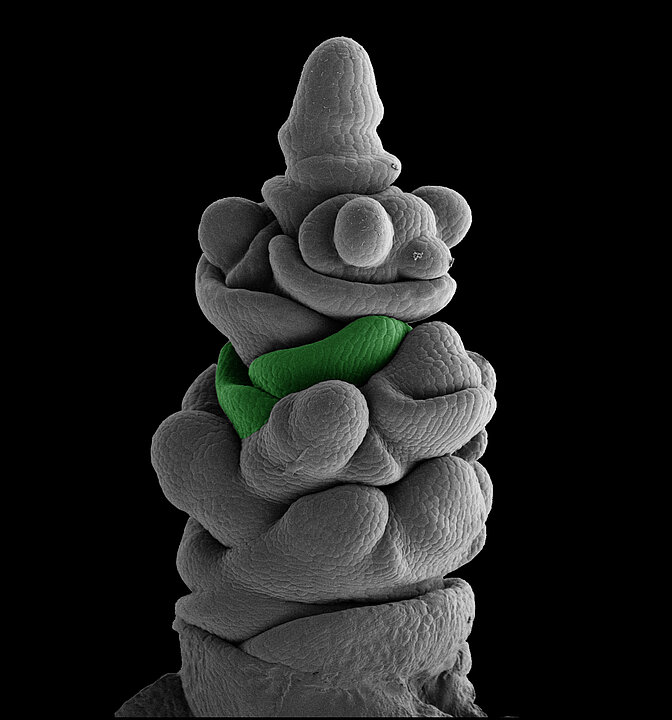Düsseldorf, Germany
February 16, 2021
A research team led by Prof. Dr. Maria von Korff Schmising from Heinrich Heine University Düsseldorf (HHU) and the Max Planck Institute for Plant Breeding Research (MPIPZ) in Cologne investigated the genetic regulation of spike development in barley and wheat. As reported in the current issue of the Proceedings of the National Academy of Sciences of the United States of America (PNAS), they discovered different barley mutants with wheat-like spikes.
 Early stage of development of the spike in an ‘intermedium-m (int-m)’ mutant in barley. The green colour shows the meristem of the glume, which surrounds a terminal floret. (Photo: HHU / Jinshun Zhong)
Early stage of development of the spike in an ‘intermedium-m (int-m)’ mutant in barley. The green colour shows the meristem of the glume, which surrounds a terminal floret. (Photo: HHU / Jinshun Zhong)
In plants, the ‘meristem’ refers to a type of tissue comprising undifferentiated cells from which various other plant organs can develop through cell division and differentiation. These ‘plant stem cells’ give rise to shoots, leaves and roots, but also spikes and flowers.
The research team including members of the Cluster of Excellence on Plant Sciences CEPLAS investigated the function of a gene responsible for the different spike forms of wheat and barley. This gene controls the activity of the spike and floret meristems and thus the number of spikelet and kernels per spike.
The closely related cool-season cereals, barley and wheat, produce variable and defined number of spikelets on their spikes, respectively. It is from these spikelets, that florets and the grains develop. The plant researchers have identified two barley mutants named ‘intermedium-m’ and ‘double seed 1’, which form a wheat-like spike with a terminal floret that consumes the spike meristem thereby reducing the number of lateral spikelets per spike. The INT-M/DUB1 gene maintains meristem identity and suppresses meristem differentiation. The ability of spike meristem to form lateral spikelets thus remains intact.
Prof. Dr. Maria von Korff Schmising, Head of the HHU Institute for Plant Genetics, about possible applications of the research findings: “These key regulators can be used to extend meristem activities. This may allow barley, wheat and other cereals to be modified to produce a higher grain yield.”
Original publication
Jinshun Zhong, G. Wilma van Esse, Xiaojing Bi, Tianyu Lan, Agatha Walla, Qing Sang, Rainer Franzen, and Maria von Korff, INTERMEDIUM-M encodes an HvAP2L-H5 ortholog and is required for inflorescence indeterminacy and spikelet determinacy in barley, PNAS 2021 Vol. 118
DOI: 10.1073/pnas.2011779118
Evolution der Getreideähren
Ein Forschungsteam um Prof. Dr. Maria von Korff Schmising von der Heinrich-Heine-Universität Düsseldorf (HHU) und dem Max-Planck-Institut für Pflanzenzüchtungsforschung (MPIPZ) in Köln haben die genetische Regulation der Ährenentwicklung in Gerste und Weizen untersucht. Sie entdeckten dabei verschiedene Mutanten der Gerste, die weizenähnliche Ähren aufweisen, wie sie in der aktuellen Ausgabe der Proceedings of the National Academy of Sciences of the United States of America (PNAS) berichten.
Bei Pflanzen bezeichnet „Meristem“ einen Gewebetyp aus undifferenzierten Zellen, aus dem sich verschiedene andere Pflanzenorgane durch Zellteilung entwickeln können. Aus diesen „Stammzellen der Pflanze“ können sich Sprossen, Blätter und Wurzeln, aber auch die Ähren und Blüten differenzieren.
Das Forschungsteam aus Mitgliedern des Exzellenzclusters CEPLAS untersuchte die Funktion eines Gens, das für die Unterschiede der verschiedenen Ährenformen von Weizen und Gerste mitverantwortlich ist. Dieses Gen kontrolliert die Aktivität der Ähren- und Blütchenmeristeme und damit die Anzahl der Blütchen und Körner pro Ähre.
Gerste und Weizen sind eng verwandte Getreidearten. Erstere produziert eine variable, zweitere eine definiert-feste Zahl von Blütchen pro Ähre. Aus diesen Blütchen entwickeln sich dann die Getreidekörner. Die Pflanzenforscherinnen und -forscher identifizierten nun zwei Gerstenmutanten mit den Namen „intermedium-m“ und „double seed 1“, die eine weizenähnliche Ährenform mit einem terminalen Blütchen – hier endet die Ähre, weil das Meristem aufgebraucht ist – und einer reduzierten Anzahl von Seitenblütchen pro Ähre bilden. Dabei trägt das Gen INT-M/DUB1 dazu bei, dass die Meristemidentität aufrechterhalten und die Differenzierung der Meristeme unterdrückt werden. So bleibt die Fähigkeit des Ährenmeristems erhalten, an den Seiten weiter Blütchenmeristeme zu bilden.
Prof. Dr. Maria von Korff Schmising, Leiterin des HHU-Instituts für Pflanzengenetik, zu möglichen Anwendungsperspektiven der Forschungsergebnisse: „Durch diese Schlüsselregulatoren können die Meristemaktivitäten verlängert werden. Damit können möglicherweise Gerste, Weizen und anderen Getreidesorten so verändert werden, dass sie einen höheren Ertrag an Körnern bringen.“
Originalpublikation
Jinshun Zhong, G. Wilma van Esse, Xiaojing Bi, Tianyu Lan, Agatha Walla, Qing Sang, Rainer Franzen, and Maria von Korff, INTERMEDIUM-M encodes an HvAP2L-H5 ortholog and is required for inflorescence indeterminacy and spikelet determinacy in barley, PNAS 2021 Vol. 118
DOI: 10.1073/pnas.2011779118